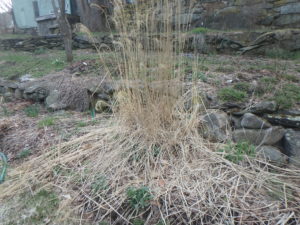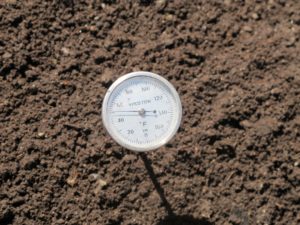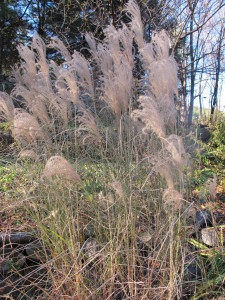Early Spring Chores
The snow is gone, and I am ready for gardening. And although I have been able to do a few things in the garden, the soil is wet and easily compacted, so I can’t do much until it dries out.
Many of my flower beds are six feet or more deep (from front to back). This means I can’t stand on the lawn and reach to the back to remove leaves or sticks. I don’t want to walk into the beds and risk compacting the soil. Plants get their oxygen through their roots, and compacted soil has little space for air. The solution? I place a plank on the soil and walk on that. It spreads out my weight.
I generally advise gardeners to wait until the lawn gets green before raking out the sand and dirt that was dumped by the snowplows. I say this because dormant grass is easily pulled up by vigorous raking. But this year I had a lot of sand, and I feared the mess would choke out large sections of lawn near the road. So I used a plastic rake, and raked gently, and I was able to clean up with very little damage to the lawn.
Other chores? If you have decorative grasses in your perennial border, it is important to cut back last year’s stems now, before new growth occurs. I don’t cut back decorative grasses in the fall: I like to see them standing up in the snow, waving in the winter wind.
I have a big clump of tall maiden grass, Miscanthus sinensis, a variety called ‘Morning Light’. Last year it had started growing before I got around to cutting it back, and there was no way to remove the bottom 8 inches of dead grass, which was unsightly. This year I cut it back low to the ground early and won’t have that problem. Hand pruners work best for cutting back the stems.
The moles and voles always make a mess of the lawn, digging up soil and leaving lumps and squiggles of soil they displaced in winter. I’ve been cleaning that up now, too. I have an aluminum grain scoop/shovel that is 14 inches across and very lightweight. I use a short-tined rock rake to dislodge the lumps and get them onto my shovel. I consider this soil a gift from the rodents. It is good soil that I use to fill holes and top-up raised beds that need some added topsoil.
Although I know people have already started their peas and spinach, my soil is awfully cold for them. Yes, you can plant the seeds when the soil is 50 degrees F, but waiting until it is 60 degrees makes sense to me. Seeds germinate much more quickly in warmer soil, so there is less chance of the seeds rotting.
A soil thermometer is not an expensive item and will last a lifetime. I have a few, and they all have dials like old-fashioned oven thermometers. The sensor is right on the tip. Keep that in mind when checking soil temperatures. If you push the tip down 6 inches, the soil will be cold at this time of year – but you are not planting seeds that deep. Instead measure the soil temperature an inch down, which means holding the thermometer upright for a couple of minutes while it adjusts. Otherwise it will fall over – hence the impulse to push it down deep.
Near the end of April I moved my cold frame out of the barn and into the garden. This is a cedar box with polycarbonate lids that allow sunshine into the box, and hold heat in. The polycarbonate helps diffuse the light, reducing chances of cooking the plants. The lids are on a slant, and open on hinges.
After a couple of sunny days the soil inside the box had warmed up, and I planted seeds of lettuce, kale and carrots inside. Once they sprout, I’ll lift the lids a little each sunny day to allow air circulation and to moderate temperatures. The box itself is 8 feet long and 2 feet across. I got mine from Gardeners Supply (www.gardeners.com or 888-833-1412).
Meanwhile, indoors, I have 5 flats of seedlings growing under lights. These require daily attention, though not much. I water, and I pluck out or snip off extra seedlings that grow. I want just one tomato plant per cell, for example, though I always plant 2 per cell just to be sure that I get one to grow. It’s hard to kill a cute little tomato plant, but I know that the survivor will do better if it’s not competing for water and nutrients.
Other early plants I have started include lettuce, kale, purple cauliflower, 3 kinds of flowers and Happy Rich. Happy Rich is a non-heading broccoli I get from Johnny’s Seeds. It produces the equivalent of side shoots on regular broccoli, but it is quicker to produce, and keeps on cranking out its green blossoms well into the fall. The part we eat is really the buds of its flowers. I have never seen Happy Rich seedlings for sale in a nursery, so I start my own each year.
Another recent chore involved taking the straw mulch off my strawberry plants. Once the plants and the new plants started by runners are awake and growing, I’ll cut any runners connected to the mother plant.
There will still be frosty nights here, and raw rainy days. But I know the worst is over, and summer is just around the corner.
Read Henry’s blog posts at https://dailyuv.com/
Picking for Vases
This is a hard time for those of us who love to go to the garden to pick flowers to grace the table. We’ve had a few weeks of cold weather, and even the hardiest of flowers seem to have faded away. So what can a gardener do?
Think outside the box. We can pick stems of shrubs with colorful or interesting bark. We can snip off branches of evergreen trees. And there are decorative grasses and even some dry weeds that have interesting form.
Actually, I do have one thing still blooming: my witchhazel (Hamamelis virginiana) shrubs are in their glory now that their leaves have dropped. They are remarkable yellow blossoms that consist of curly yellow straps. Their fall foliage is yellow and the blossoms appear while the leaves are still on the branches – and are easily missed. Now the leaves are gone and the blossoms are prominent.
Witchhazel comes in several species. There is a spring blooming variety, H. vernalis, that blooms as early as March. Some varieties of this species also have spectacular fall leaf color. The variety ‘Autumn Embers’, a spring bloomer, has great fall color. I have yet to try this species, but it’s on my wish list.
Most grasses and branches lend themselves to making big arrangements. I decided to try working with some to make something shorter as tall arrangements on the dining room table block my vision of a diner across from me. I cut stems of fountain grass (Miscanthus sinensis) which is well over 6 feet tall in my garden, but I just used the top 18 to 24 inches of each stem. They are in blossom right now, meaning that they display fluffy plumes above the foliage.
I also cut the bare red stems of red-twigged dogwood, which is also known as red osier dogwood (Cornus sericea). This is a plant that I cut to the ground each spring. New growth has bright red bark that seems to get brighter in the winter. In the wild it lives in wet places, and I grow it in moist soils, but it will grow in ordinary garden soil. I cut it back to keep the size in check, but mostly to get bright red color. Other varieties of the species produce yellow stems.
So I had bright red in the vase, and tawny beige grasses. I needed some greenery. I have lots of Canadian hemlock, but have found that the needles do not hold on well. White pine would work, but I wanted a different look. I cut a few stems of a hellebore, a perennial flower with evergreen leaves. The stems rise up a foot or so, then send out horizontal clusters of shiny green leaves, which seemed perfect. The leaves did well for a couple of days, then got droopy.
Other plants that often have good looking leaves at this time of year include European wild ginger (Asarum europaeum), dead nettle (Lamium spp.), myrtle or periwinkle (Vinca minor) and pachysandra (Pachysandra spp.). And although a vase full of just leaves may not be interesting in summer, a little greenery in a low bowl with a few stones is not bad now.
Of the leaves mentioned above, pachysandra is the best: it will last all winter in a vase, rooting and looking perky. Pick some now for use all winter.
In my vegetable garden I still have a number of plants that might also look good in a vase. Kale comes in a variety of colors and leaf types. All do well in a vase, and purple kale can be very striking. Mint also holds up for several days in a vase – and you can nibble on the leaves.
If you grew last winter’s amaryllis outdoors in a pot all summer, (hoping it might re-bloom for you this year), now is the time to give some tough love. You need to stop watering it, and let the leaves yellow and die. Cut off the leaves and keep it in a cool dark place for six weeks. It needs that dormant time if it is to re-bloom.
I usually take my amaryllis out of its pot, shake off any soil, and put it in a brown paper bag. Then I store it in my basement, which is between 45 and 55 degrees at this time of year, which is perfect. After 6 weeks I re-pot it and bring it up into the warmth of the house, but keep it out of direct sunshine for a while. Date the bag so you will know when to bring it into the light.
If you want to be sure of having a blooming amaryllis for the holiday season, go buy one now. They generally come with all you need: pot, potting soil, instructions. Don’t overwater it as the bulbs can rot. And this advice: bigger, more expensive bulbs are worth the money. The cheap ones you can get in a Big Box store will bloom, but you will probably just get one bloom stem, not two, and the blossoms will generally not be nearly as dramatic, nor be as numerous. I’ve learned the hard way.
Winter is breathing down our necks. I’m using the woodstove almost every day. And although I get a few things from my garden to put in a vase, I like to visit my local florist and buy some real flowers, too. If you’re on a limited budget, ask your florist for flowers that will last well in a vase. We gardeners all need flowers- even winter!
Henry is a garden consultant, coach, and a UNH Master Gardener. His web site is www.Gardening-guy.com.







